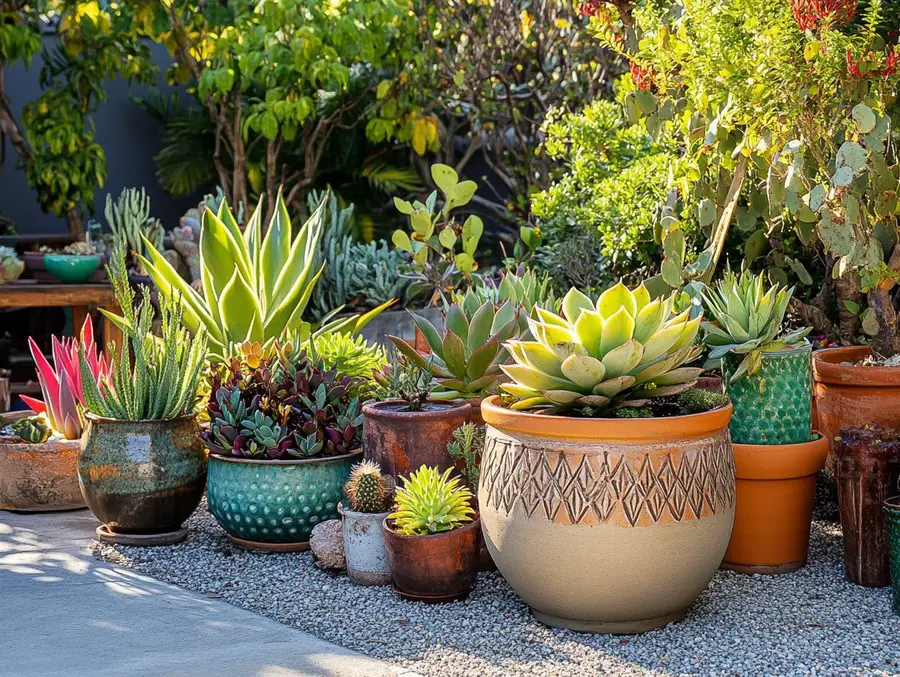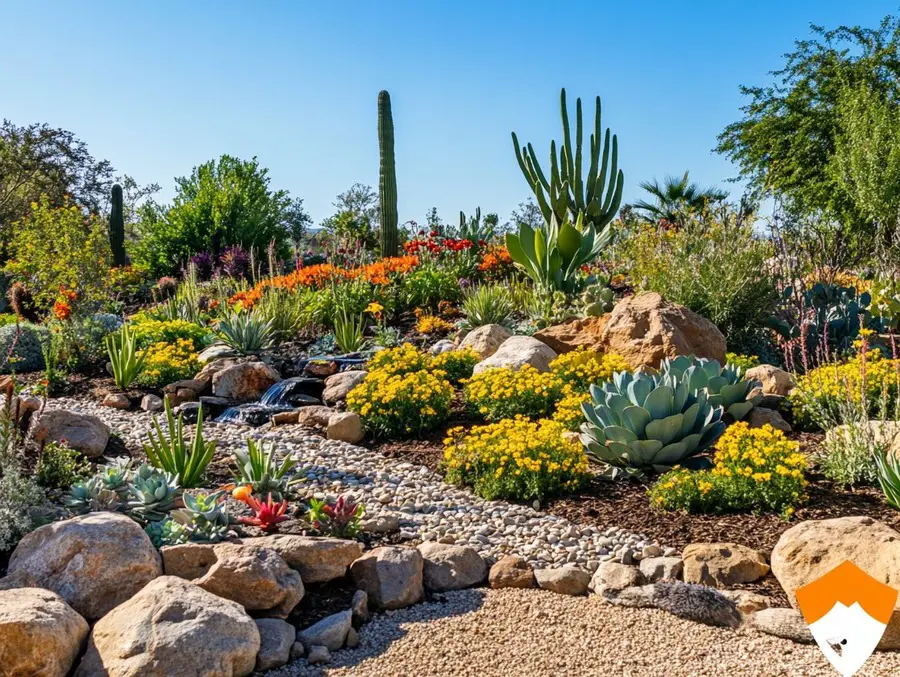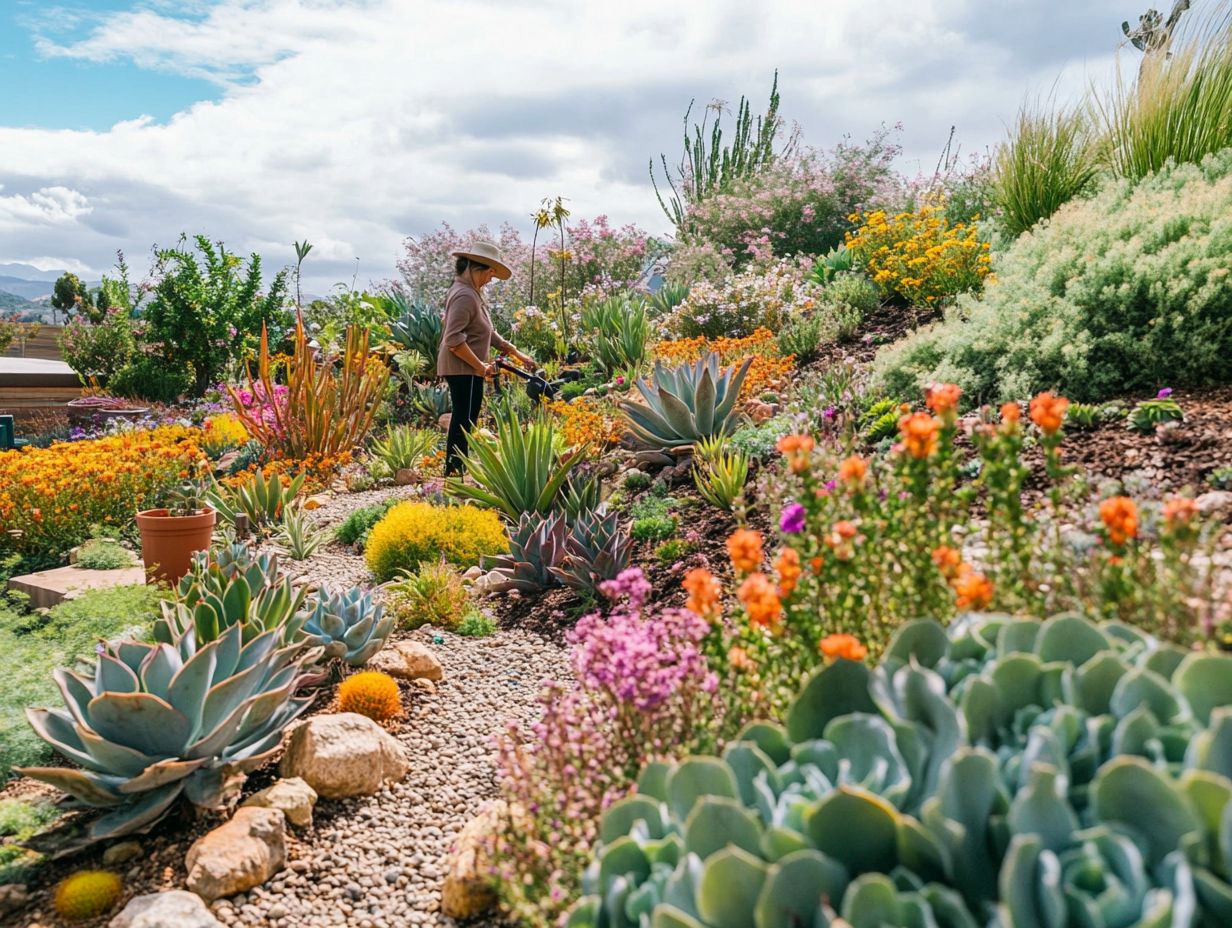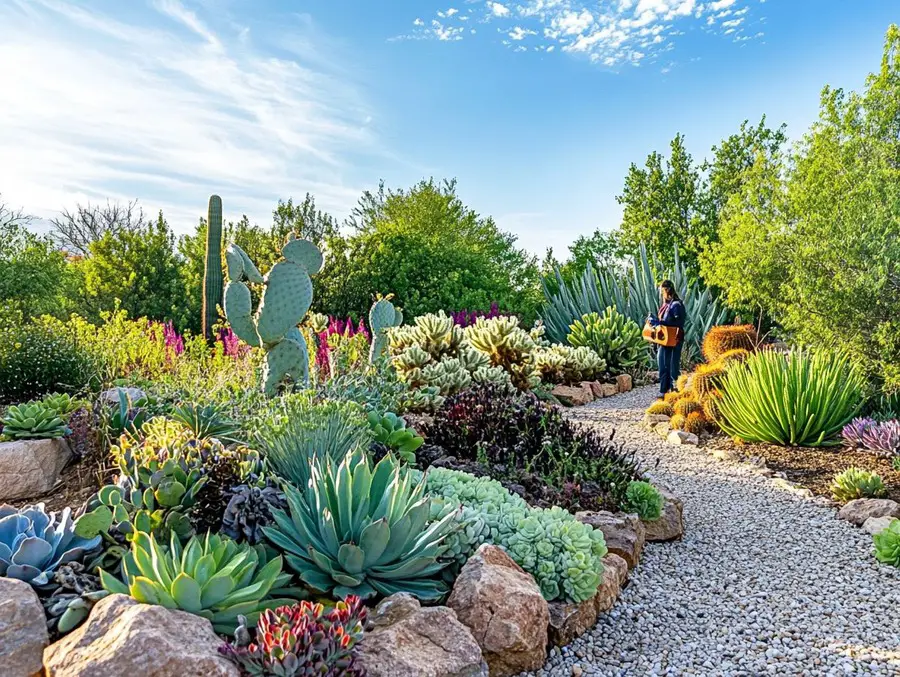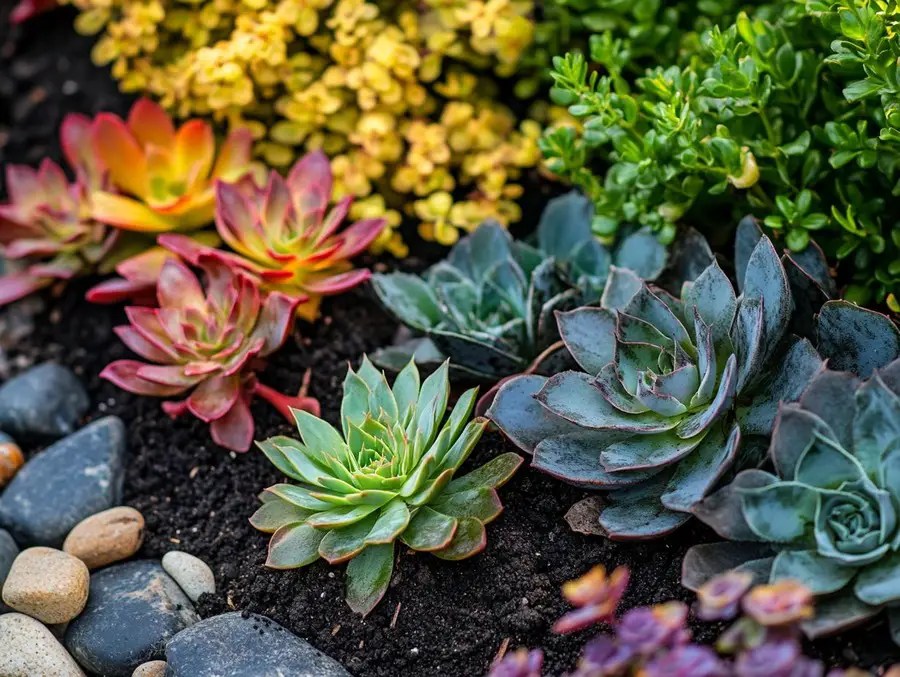We use affiliate links. If you purchase something using one of these links, we may receive compensation or commission.
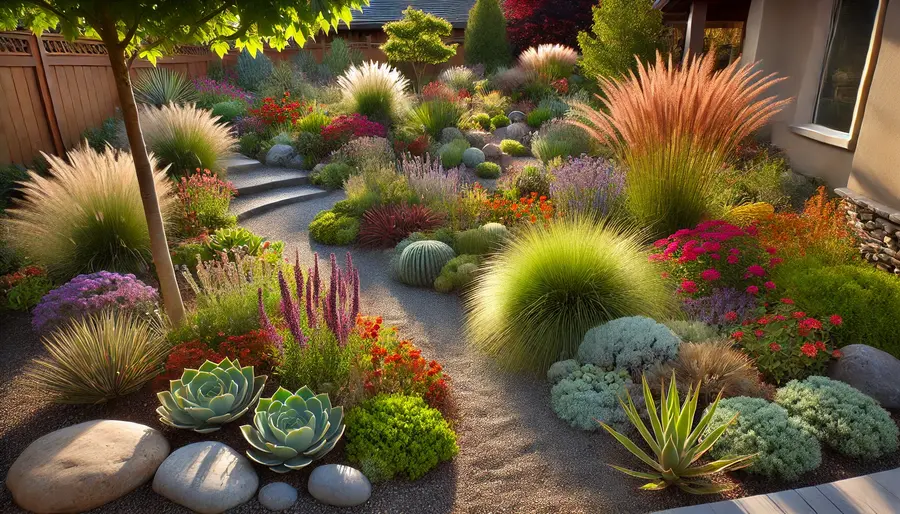
The Best Plants for Xeriscape Gardens make it easy to have a beautiful yard without the hassle of constant watering.
Tired of watching plants struggle in dry conditions? The right drought-tolerant plants thrive with minimal care while adding texture and color.
Let’s go over the best options to create a lush, low-maintenance xeriscape.
Best Plants for Xeriscape Gardens Key Takeaways
- Best Plants for Xeriscape Gardens thrive with minimal water while adding color, texture, and structure.
- Top choices include agave, lavender, yarrow, and ornamental grasses.
- Native perennials, drought-resistant shrubs, and ground covers help reduce maintenance while keeping the garden vibrant.
- Selecting the right plants ensures a lush, water-efficient xeriscape year-round.
1. What Makes a Plant Ideal for Xeriscaping?
Choosing the right plants is the most important step in creating a xeriscape that thrives with minimal effort.
But not all drought-resistant plants are a good fit. Some can handle weeks without water, while others need a little moisture to stay healthy.
Understanding what makes a plant truly xeric will help you pick options that look great year-round without constant upkeep.
How to Identify the Best Xeriscape Plants
Plants that do well in low-water gardens tend to share a few common traits. Keep an eye out for these natural adaptations:
✅ Deep Root Systems
- Plants with long roots can pull moisture from deep in the soil.
- Trees like mesquite and palo verde tap into underground water sources.
- Perennials such as yarrow and coneflower grow deep roots, making them drought-hardy.
✅ Thick, Waxy, or Fuzzy Leaves
- Leaves with a waxy coating or fine hairs help reduce evaporation.
- Lavender, sage, and lamb’s ear hold in moisture with their fuzzy texture.
- Succulents like agave and aloe vera store water in their thick leaves.
✅ Slow Growth Patterns
- Fast-growing plants use more water to support their rapid expansion.
- Drought-tolerant plants grow at a steady, slow pace, needing fewer resources.
- Russian sage and Texas sage are great examples—they take their time but stay strong through heat and dry spells.
✅ Adaptability to Local Soil & Climate
- Some plants need rich, fertile soil to thrive—not ideal for xeriscaping.
- The best xeric plants handle poor soil conditions and still grow strong.
- Native plants are the ultimate survivors because they’re already used to the local environment.
📌 Pro Tip: Native plants are always a smart choice—they’re already adapted to the region, require little care, and attract local pollinators.
🔗 Related Read: Budget-Friendly Xeriscaping for Beginners
What to Avoid When Selecting Xeriscape Plants
Not all drought-resistant plants are good for every region.
Some thrive in hot deserts, while others do better in mild, dry climates. Here’s what to watch out for:
🚫 Plants That Need Extra Care
- Some plants marketed as drought-tolerant still need occasional deep watering.
- Example: Hydrangeas are sometimes labeled drought-resistant but still wilt in extreme heat.
🚫 Invasive Species
- Some low-water plants spread too aggressively, choking out native plants.
- Example: Pampas grass looks great but takes over quickly and is tough to remove.
🚫 Overly Thirsty Desert Plants
- Some desert plants store water but still need occasional rain.
- Example: Some species of prickly pear cactus need seasonal rainfall to stay healthy.
📌 Pro Tip: If you’re unsure, check with local nurseries or extension offices for the best xeric plants for your area.
Making the Right Choice for Your Yard
The best xeriscape plants don’t just survive on little water—they thrive.
By picking plants with deep roots, water-saving leaves, slow growth, and local adaptability, you’ll build a garden that stays lush without constant care.
2. Drought-Tolerant Perennials for Long-Lasting Beauty
Perennials are a must-have in a xeriscape garden. Unlike annuals that need replanting each year, perennials return season after season, making them a low-maintenance and cost-effective choice.
Many drought-tolerant perennials have deep roots, which help them survive on rainwater alone once established.
They also bring color, texture, and pollinator-friendly blooms to your yard.
If you want a xeriscape that looks great year-round, these perennials are a great place to start.
Best Drought-Tolerant Perennials for Xeriscaping
✅ Yarrow (Achillea millefolium)
- Feathery, fern-like foliage with clusters of small flowers in yellow, pink, or red.
- Attracts bees and butterflies while needing very little water.
- Thrives in hot, dry conditions and tolerates poor soil.
✅ Lavender (Lavandula spp.)
- Known for its fragrant purple blooms and silvery-green foliage.
- Repels mosquitoes and deer while attracting pollinators.
- Grows well in gravelly, sandy soils with full sun exposure.
✅ Russian Sage (Perovskia atriplicifolia)
- Tall, airy stems covered in delicate purple flowers.
- Can handle intense heat and drought with little care.
- Great for filling in large spaces with soft, flowing movement.
✅ Coneflower (Echinacea purpurea)
- Iconic daisy-like flowers with bold pink, purple, or white petals.
- Deep root system makes it extremely drought-resistant.
- Attracts butterflies, hummingbirds, and bees.
✅ Black-Eyed Susan (Rudbeckia hirta)
- Bright yellow petals with a dark brown center.
- Survives hot, dry summers without supplemental watering.
- Adds seasonal color and thrives in most soil types.
✅ Penstemon (Penstemon spp.)
- Tubular flowers in red, pink, or purple that hummingbirds love.
- Thrives in gritty, rocky soil with minimal water.
- Blooms in spring and summer, adding color early in the season.
📌 Pro Tip: Many perennials bloom in spring and summer, but pairing them with ornamental grasses or evergreen shrubs keeps your xeriscape attractive year-round.
🔗 Related Read: Perennials for Xeriscaping
How to Care for Drought-Tolerant Perennials
Once established, these plants require very little care, but a few small steps will keep them thriving.
💧 Water deeply during the first year – Even drought-resistant plants need a little extra help at first. Water once a week until roots are strong.
✂️ Deadhead spent blooms – Removing faded flowers encourages longer blooming seasons.
🌿 Prune lightly in early spring – Cutting back dead growth keeps plants healthy and bushy.
🍂Mulch around plants – A layer of gravel or wood mulch helps hold in moisture and reduce weeds.
📌 Pro Tip: Group perennials by water needs to avoid overwatering low-water plants or underwatering ones that need a little more moisture.
Bringing Perennials Into Your Xeriscape
Drought-tolerant perennials are a perfect backbone for any xeriscape garden.
They return year after year, handle heat and dry soil, and bring pollinators, color, and texture to your space.
Pair them with grasses, succulents, or shrubs for a xeriscape that stays lively in every season.
3. Tough, Low-Water Shrubs for Structure
Shrubs are the backbone of a xeriscape garden.
They provide height, privacy, shade, and year-round texture without needing constant watering.
Many drought-tolerant shrubs have deep roots, waxy or small leaves, and slow growth, making them perfect for low-maintenance, water-wise gardens.
If you want a xeriscape that looks full and structured without extra work, these shrubs are a solid choice.
Best Low-Water Shrubs for Xeriscaping
✅ Texas Sage (Leucophyllum frutescens)
- Silver-green foliage with purple flowers after rain.
- Thrives in hot, dry conditions and needs almost no care.
- Attracts pollinators while staying deer-resistant.
✅ Red Yucca (Hesperaloe parviflora)
- Long, spiky leaves with tall coral-colored flower stalks.
- Survives extreme heat and cold without extra watering.
- Hummingbirds love the nectar-rich flowers.
✅ Rosemary (Rosmarinus officinalis)
- Fragrant evergreen shrub that doubles as an herb.
- Requires very little water once established.
- Grows well in rocky, sandy soil.
✅ Desert Willow (Chilopsis linearis)
- Small tree-like shrub with delicate pink flowers.
- Handles intense heat, drought, and poor soil.
- Attracts butterflies and hummingbirds.
✅ Brittlebush (Encelia farinosa)
- Soft gray-green leaves with bright yellow flowers in spring.
- Loves full sun and can survive on rainfall alone.
- Works well as ground cover on slopes to prevent erosion.
📌 Pro Tip: Shrubs make great windbreaks and erosion control in dry, sloped areas.
🔗 Related Read: Shrubs for Xeriscaping
How to Care for Drought-Tolerant Shrubs
Once established, these shrubs practically take care of themselves, but a little maintenance helps them look their best.
💧 Water deeply at first – Even drought-tolerant shrubs need water in their first year. Water once a week until established.
✂️ Prune lightly – Trim dead branches in early spring to keep shrubs compact and healthy.
🍂Mulch at the base – A layer of gravel or bark mulch helps retain moisture and suppress weeds.
🌞 Full sun is best – Most drought-tolerant shrubs thrive in direct sunlight.
📌 Pro Tip: Avoid overwatering! Too much moisture can cause root rot in these low-water plants.
Why Shrubs Are Essential in a Xeriscape
Shrubs add structure, color, and function to xeriscaping.
Whether you need privacy, erosion control, or a low-maintenance green space, these hardy, water-wise shrubs are the way to go.
4. Ornamental Grasses for Movement & Texture
Ornamental grasses bring softness, height, and motion to a xeriscape garden.
They thrive in dry conditions, require minimal upkeep, and add seasonal interest with changing colors.
Whether you want ground cover, vertical accents, or flowing texture, grasses are a perfect choice.
If you want a xeriscape that feels lively and well-balanced, these grasses will do the trick.
Best Ornamental Grasses for Xeriscaping
✅ Blue Fescue (Festuca glauca)
- Compact, icy-blue tufts that contrast with warm-toned plants.
- Perfect for borders, containers, or mass plantings.
- Stays low-maintenance and evergreen in mild climates.
✅ Muhly Grass (Muhlenbergia capillaris)
- Feathery, pink plumes in fall for a dramatic look.
- Drought-tolerant once established and thrives in poor soil.
- Looks stunning when planted in clusters.
✅ Fountain Grass (Pennisetum alopecuroides)
- Arching, foxtail-like seed heads add softness and texture.
- Prefers well-draining soil and full sun.
- Works great along pathways and borders.
✅ Little Bluestem (Schizachyrium scoparium)
- Green in summer, turning rust-orange in fall.
- Deep roots make it incredibly drought-tolerant.
- Attracts birds and pollinators with its seed heads.
✅ Mexican Feather Grass (Nassella tenuissima)
- Delicate, wavy seed heads create constant movement.
- Needs very little water and thrives in gravelly soil.
- Pairs well with succulents, wildflowers, and rock gardens.
📌 Pro Tip: Mix grasses with succulents, shrubs, or perennials for a balanced xeriscape.
🔗 Related Read: Ornamental Grasses for Xeriscaping
🔗 Related Read: Coastal Plants for Xeriscaping
How to Care for Drought-Tolerant Grasses
Ornamental grasses are one of the easiest plants to maintain in a xeriscape. A little care keeps them healthy and full year-round.
💧 Water sparingly – Once established, grasses only need occasional deep watering during long dry spells.
✂️ Cut back once a year – Trim in late winter or early spring to encourage fresh growth.
🍂 Mulch around the base – A layer of gravel or bark mulch helps hold moisture and suppress weeds.
🌞 Give them sun – Most xeric grasses need at least 6 hours of direct sunlight per day.
📌 Pro Tip: Divide clumps every 3-4 years to keep grasses from overcrowding and improve growth.
Why Ornamental Grasses Belong in a Xeriscape
Grasses add texture, movement, and year-round interest without demanding extra water.
Whether you need a border, a focal point, or erosion control, these tough, water-wise grasses are a great addition to any xeriscape.
5. Flowering Plants for Seasonal Color
Xeriscaping doesn’t mean settling for a dull, dry garden.
Plenty of drought-tolerant flowers bring bold colors, attract pollinators, and thrive with little water.
With the right mix of perennials, wildflowers, and flowering shrubs, your xeriscape can bloom from spring to fall while staying low-maintenance.
If you want a xeriscape that feels alive and vibrant, these flowering plants will do the job.
Best Flowering Plants for Xeriscaping
✅ Blanket Flower (Gaillardia)
- Blooms all summer in red, orange, and yellow shades.
- Handles heat, drought, and poor soil with ease.
- Attracts bees and butterflies for a pollinator-friendly garden.
✅ Black-Eyed Susan (Rudbeckia hirta)
- Classic golden-yellow petals with a dark center.
- Can survive on rainwater alone once established.
- Works well in wildflower gardens and mass plantings.
✅ Salvia (Salvia greggii)
- Long-lasting red, pink, or purple flowers that bloom spring to fall.
- Needs very little water and thrives in rocky or sandy soil.
- Hummingbirds love the nectar-rich blooms.
✅ Penstemon (Penstemon spp.)
- Tall spikes of tubular flowers in red, pink, purple, or blue.
- Thrives in hot, dry climates and attracts pollinators.
- Perfect for xeriscape borders and rock gardens.
✅ Verbena (Verbena rigida)
- Low-growing plant with clusters of purple flowers.
- Blooms from spring through fall with minimal water.
- Spreads as a drought-resistant ground cover.
📌 Pro Tip: Combine early bloomers (salvia, penstemon) with late bloomers (blanket flower, black-eyed Susan) for continuous color.
🔗 Related Read: Flowering Plants for Xeriscaping
🔗 Related Read: Container Plants for Xeriscaping
How to Keep Xeriscape Flowers Blooming Longer
Flowering plants in a xeriscape need very little care, but a few small steps will keep them blooming all season.
💧 Water deeply when first planted – Most drought-tolerant flowers need a little extra help in the first few months.
✂️ Deadhead spent blooms – Removing old flowers encourages new ones to keep blooming.
🪨 Use gravel or mulch – This helps retain moisture and reduce weeds around the plants.
🌞 Plant in full sun – Most xeric flowers need 6+ hours of sunlight to bloom their best.
📌 Pro Tip: Some flowers self-seed, meaning they drop seeds and regrow the next year. Letting verbena, blanket flower, and black-eyed Susan go to seed can fill in your xeriscape naturally.
Why Flowering Plants Belong in a Xeriscape
Flowers bring color, texture, and pollinators into a xeriscape without needing extra work.
Whether you’re looking for low-maintenance ground covers, bold perennials, or hummingbird-friendly blooms, these drought-tolerant flowers will keep your garden lively all season.
6. Succulents & Cacti for Low-Maintenance Beauty
If you want a xeriscape that thrives in dry conditions while staying visually interesting, succulents and cacti are the perfect fit.
These plants store water in their leaves, stems, or roots, making them ultra-resilient and able to withstand long periods without rain.
They also add unique shapes, colors, and textures that break up traditional plant groupings.
If you want a xeriscape that’s bold, low-maintenance, and full of character, these succulents and cacti are great choices.
Best Succulents & Cacti for Xeriscaping
✅ Agave (Agave spp.)
- Large, dramatic rosettes with thick, spiky leaves.
- Thrives in rocky, well-drained soil and needs almost no water.
- Comes in different sizes, from small Agave parryi to massive Agave americana.
✅ Aloe Vera (Aloe barbadensis)
- Famous for its soothing gel, but also a beautiful xeriscape plant.
- Needs very little water and thrives in pots or in-ground plantings.
- Grows best in full sun with well-drained soil.
✅ Prickly Pear Cactus (Opuntia spp.)
- Flat, paddle-shaped stems with seasonal yellow, orange, or pink flowers.
- Edible fruit and pads, often used in cooking.
- Handles harsh sun, poor soil, and extreme drought.
✅ Sedum (Stonecrop)
- Low-growing succulent with thick, fleshy leaves in shades of green, red, and purple.
- Perfect as a drought-tolerant ground cover or border plant.
- Blooms small star-shaped flowers that attract pollinators.
✅ Hens and Chicks (Sempervivum spp.)
- Compact, rosette-shaped succulents that spread by producing baby plants.
- Thrives in rock gardens, containers, and dry areas with minimal care.
- Cold-hardy and survives in hot summers and freezing winters.
📌 Pro Tip: Plant succulents and cacti in gravel beds or raised rock gardens for proper drainage—soggy roots will kill them fast!
🔗 Related Read: Succulents for Xeriscaping
How to Care for Xeriscape Succulents & Cacti
Once planted, succulents and cacti need very little maintenance, but they’ll thrive with a few simple care tips.
💧 Water deeply, but rarely – A good soak once every few weeks is better than frequent shallow watering.
🪨 Use fast-draining soil – A mix of sand, gravel, and cactus soil prevents root rot.
🌞 Give them full sun – Most succulents and cacti need at least 6 hours of sunlight per day.
✂️ Remove dead or damaged leaves – Keeps plants looking neat and prevents rot.
📌 Pro Tip: Avoid overwatering! Too much moisture is the #1 killer of succulents and cacti in xeriscapes.
Why Succulents & Cacti Are Perfect for Xeriscaping
These plants add bold shapes, water-saving efficiency, and effortless maintenance to any xeriscape.
Whether you want spiky, dramatic cacti or soft, rosette-shaped succulents, they provide eye-catching structure with almost no effort.
7. Ground Covers to Replace Grass
Traditional lawns are thirsty, high-maintenance, and costly to keep green—especially in dry climates.
That’s why many xeriscape gardens swap grass for drought-tolerant ground covers that thrive with little to no watering.
These low-growing plants fill in spaces, suppress weeds, and create a lush, natural look without constant mowing or irrigation.
If you want a xeriscape that stays green without the hassle of grass, these ground covers are the way to go.
Best Ground Covers for Xeriscaping
✅ Creeping Thyme (Thymus serpyllum)
- Tiny purple or pink flowers bloom in summer.
- Handles foot traffic, making it great for pathways and patios.
- Releases a light, pleasant scent when stepped on.
✅ Ice Plant (Delosperma cooperi)
- Thick, succulent-like leaves with bright pink, purple, or yellow flowers.
- Spreads quickly, making it great for covering large areas.
- Stores water in its leaves, needing almost no irrigation.
✅ Blue Star Creeper (Isotoma fluviatilis)
- Tiny blue flowers and soft green foliage.
- Works well between stepping stones or as a lawn alternative.
- Stays low-growing and dense, requiring little upkeep.
✅ Drought-Tolerant Sedum (Sedum spp.)
- Thick, fleshy leaves that store water, perfect for dry conditions.
- Comes in different colors and textures, from bright green to deep red.
- Requires zero maintenance once established.
✅ Lippia (Phyla nodiflora)
- Fast-spreading, heat-loving ground cover.
- Produces tiny purple and white flowers that attract pollinators.
- Can handle foot traffic, making it a great lawn substitute.
📌 Pro Tip: Use a mix of different ground covers to create variety in texture and color while keeping water use low.
🔗 Related Read: Best Ground Covers for Xeriscaping
How to Replace Grass with Drought-Tolerant Ground Covers
💧 Water during the first few months – Even low-water ground covers need a little extra help until they’re established.
🌞 Plant in full sun for best growth – Most ground covers thrive in direct sunlight, but some like blue star creeper can tolerate shade.
🪨 Mulch between plants – This prevents weeds and helps the soil retain moisture.
✂️ Trim or mow occasionally – Some varieties like lippia benefit from an occasional low trim to keep them looking neat.
📌 Pro Tip: Ground covers help cool the soil, prevent erosion, and reduce dust—making them a practical and beautiful alternative to grass.
Why Ground Covers Are a Smart Xeriscape Choice
Ditching traditional grass for low-water ground covers saves time, money, and effort.
Whether you choose flowering thyme, spreading ice plant, or hardy sedum, these easy-care alternatives will keep your xeriscape looking lush without the constant watering, mowing, and fertilizing.
8. Trees for Shade & Year-Round Interest
Even xeriscapes benefit from shade trees, which cool down outdoor spaces and reduce water loss.
- Desert Willow – Light pink blooms, great for small yards.
- Palo Verde – Yellow flowers and green bark, thrives in heat.
- Mesquite – Low-water, fast-growing shade tree.
- Olive Tree (Non-Fruiting) – Classic, drought-hardy, and evergreen.
📌 Pro Tip: Plant trees in the western part of your yard to block the harsh afternoon sun.
🔗 Related Read: Trees for Xeriscaping
Bringing It All Together
The right plants make xeriscaping simple and stunning.
By choosing drought-resistant perennials, shrubs, grasses, succulents, and trees, you’ll build a garden that thrives with minimal water.
9. Bringing It All Together
A xeriscape garden should be beautiful, low-maintenance, and water-efficient.
The right plants make all the difference, transforming dry, barren spaces into lush, thriving landscapes that require minimal upkeep.
By choosing a mix of drought-tolerant perennials, shrubs, ornamental grasses, succulents, ground covers, and trees, you can create a balanced, colorful, and resilient garden that works with nature instead of against it.
How to Design a Well-Balanced Xeriscape Garden
A great xeriscape isn’t just about picking plants at random—it’s about layering them strategically for visual interest and functionality.
🌱 Start with structural plants – Use shrubs and trees as the foundation for shade and height.
🌾 Fill in with ornamental grasses – These add movement, texture, and seasonal color.
🌼 Add perennials and flowering plants – Introduce long-lasting color and pollinator-friendly blooms.
🪨 Use succulents and cacti as accents – Their bold shapes and water-storing abilities make them perfect focal points.
🌿 Replace grass with ground covers – This keeps the garden lush without the need for mowing or watering.
📌 Pro Tip: Group plants by water needs (hydrozoning) to make irrigation more efficient—keep thirstier plants together and let low-water plants thrive in drier zones.
How to Keep Your Xeriscape Thriving Year-Round
Once your xeriscape is fully planted and established, keeping it healthy is simple.
💧 Water deeply but infrequently – Encourage deep root growth by soaking plants every few weeks instead of shallow watering daily.
🌞 Prune seasonally – Cut back grasses, shrubs, and perennials in late winter or early spring to promote fresh growth.
🪨 Mulch regularly – Use gravel, bark, or decomposed granite to retain moisture and prevent weeds.
🌸 Rotate seasonal flowers – Add wildflowers or flowering perennials to keep colors changing throughout the year.
📌 Pro Tip: A xeriscape is not a “set it and forget it” garden—it evolves over time. Let plants fill in naturally, adjust plant placement if needed, and experiment with different textures and colors.
Why Xeriscape Gardens Are the Future of Sustainable Gardening
A xeriscape isn’t just a way to save water—it’s a smart, sustainable approach to gardening that helps you spend less time working in your yard and more time enjoying it.
✅ Cuts water use by 50-75% – Perfect for dry climates and drought-prone areas.
✅ Low-maintenance design – Less watering, no mowing, and fewer weeds.
✅ Visually stunning – With the right plant choices, a xeriscape is just as lush and colorful as a traditional garden.
✅ Supports pollinators & wildlife – Many xeric plants attract bees, butterflies, and hummingbirds.
FAQ Section: Best Plants for Xeriscape Gardens
Xeriscaping is all about choosing the right plants to save water while keeping your garden beautiful. If you’re new to xeriscaping, you might have some questions about which plants work best and how to care for them.
Here are some quick answers to help you get started.
Q: What are the best plants for xeriscaping?
A: The best xeriscape plants are drought-tolerant, low-maintenance, and adapted to dry conditions.
Top choices include lavender, yarrow, Russian sage, agave, prickly pear cactus, and ornamental grasses. Native plants are also great because they naturally thrive in the local climate with minimal care.
Q: How do I choose the right xeriscape plants for my area?
A: Start by checking your USDA plant hardiness zone and researching native plants that grow well in your region.
Look for plants with deep roots, small or waxy leaves, and slow growth—these traits help them conserve water and withstand heat.
Q: Do xeriscape plants need any watering at all?
A: Yes, but much less than traditional gardens. Most xeriscape plants need deep watering during the first year to establish strong roots.
After that, they can often survive on rainfall alone or an occasional deep soak every few weeks during dry spells.
Q: What are the best flowering plants for xeriscaping?
A: Many drought-tolerant flowers thrive in xeriscapes, including black-eyed Susan, blanket flower, salvia, penstemon, and coneflower.
These plants provide bright, long-lasting blooms while requiring very little water.
Q: Can I have trees in a xeriscape garden?
A: Absolutely! The best xeriscape trees include desert willow, palo verde, mesquite, and non-fruiting olive trees.
These trees provide shade, reduce water loss, and require minimal maintenance once established.
Q: What is a good ground cover for xeriscaping?
A: The best drought-tolerant ground covers include creeping thyme, ice plant, sedum, and blue star creeper.
These plants fill in spaces, reduce weeds, and keep soil cool without needing frequent watering.
Q: Can I mix succulents with other xeriscape plants?
A: Yes! Succulents like agave, aloe, and hens and chicks pair well with ornamental grasses, flowering perennials, and low-water shrubs.
Just be sure they all have well-draining soil and are grouped by similar water needs.
Q: How do I keep my xeriscape plants healthy year-round?
A: Xeriscape plants are low-maintenance, but a few simple tasks keep them looking great:
- Water deeply but infrequently to encourage strong roots.
- Prune perennials and grasses in early spring for fresh growth.
- Use gravel or mulch to retain moisture and prevent weeds.
- Group plants by water needs for efficient irrigation.
Q: Do xeriscape plants attract pollinators?
A: Yes! Many xeriscape plants are pollinator-friendly, attracting bees, butterflies, and hummingbirds.
Some of the best options include lavender, salvia, penstemon, and coneflowers.
Q: Can I still have color in a xeriscape garden?
A: Definitely! Drought-tolerant flowers, colorful succulents, and evergreen shrubs keep xeriscapes looking vibrant all year.
Consider plants like red yucca, purple Russian sage, yellow yarrow, and pink muhly grass for seasonal color.
Xeriscape gardening is easy, water-efficient, and beautiful with the right plant choices.
Whether you’re looking for low-maintenance flowers, shade trees, or a grass alternative, there’s a perfect plant for your space.
Xeriscape Garden Styles: Easy Low-Maintenance Options
Xeriscape Garden Design & Layout: Easy Water-Wise Beauty
Xeriscape Gardening Techniques: Easy Low-Water Tips
What is xeriscaping? A beginner’s guide to drought-tolerant landscaping – Colorado State University
Related Content
Visit my Amazon Influencer Page for videos and gardening products Grow Your Own Garden

